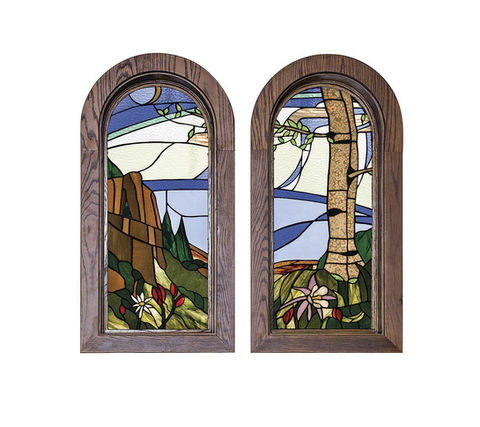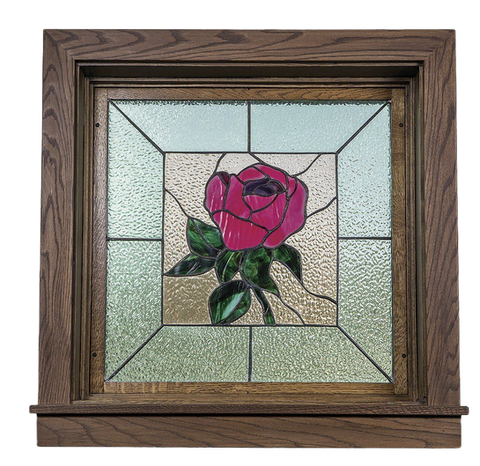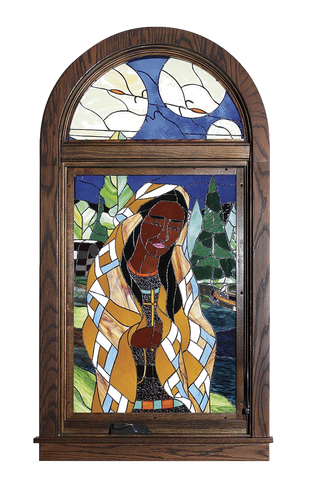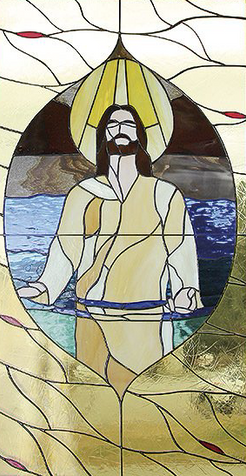
Church Tour
Welcome to our beautiful Church located in the mountains of Northwestern Colorado. Feel free to print this page when visiting our parish as a guide for walking around the environment and seeing all the amazing details and meaning behind each and every architectural element.
EXTERIOR
For this section, click into image for more information!
INTERIOR
For this section, click into image for more information!
THE HEAVENS
For this section, click into image for more information!
WINDOWS | Creation
The high windows above the nave express the creation sequence based on the first three chapters of the Book of Genesis. They were designed by parishioner, Gregory Effinger, and assembled by parishioner Georgian Kalow and a team of fifty local artisans. From the sanctuary to the main entrance on the Oak Street side of the church, there are six sets of windows.
SYMBOLOGY
The high windows above the nave express the creation sequence based on the first three chapters of the Book of Genesis. They were designed by parishioner, Gregory Effinger, and assembled by parishioner Georgian Kalow and a team of fifty local artisans. From the sanctuary to the main entrance on the Oak Street side of the church, there are six sets of windows.
TREE OF LIFE
The mystical Tree of Life frames the Bible like its first and last books (Genesis 2:9; 3:24; and Revelation 22:14). At its base we can see two of the four rivers mentioned in Genesis (2:10–14) nourishing the ancient roots. The tree’s great age and height is suggested by the size of a majestic bull elk standing on the lower right. As the tree ascends to the sky, we notice that its branches support various birds, along with fruits, representing the fruits of the Holy Spirit (love, joy, peace, patience, kindness, goodness, faithfulness, gentleness and self-control (Galatians 5:22–23). The glorious tree, very much alive, seems to have been growing forever.

LUMINOUS MYSTERIES
The Holy Name of Jesus the Christ and Messiah, all point us to the Incarnation, the Anointed One, the King of Kings. Our Lord gradually revealed himself as savior and king throughout his earthly ministry culminating in his death, resurrection, and ascension. The other windows in the clerestory and transepts sum up this gradual revelation. We start with the Luminous Mysteries of the Rosary that were identified and composed by Pope Saint John Paul II, The Baptism of Christ, the Wedding at Cana, the Proclamation of the Kingdom and The Transfiguration of Christ.
I AM WINDOWS
On either side of the sanctuary, three sets of three windows outline the transept (the horizontal arms of the cruciform church). These six triptychs reveal Jesus as the human incarnation of the God who spoke from the Burning Bush and who continues to abide with us in the Tabernacle. These windows display Jesus identifying Himself with the Holy Name “I Am” in the Gospel according to St. John.
I Am the Light of the World, I Am the Good Shepherd, I Am the Bread of Life, I Am the Vine, I Am the Resurrection and the Life, I Am the Way, the Truth and the Life
SAINTS AND MARTYRS
On either side of the sanctuary, several sets of windows show Martyrs from all over the world. Pictured below are several.
PENTACOST CONTINUES
A uniquely daring depiction of how the Holy Spirit continues to give birth to the Church is shown in the largest window of the north transept. This complex window merits a de-tailed explanation.
Filled with the Holy Spirit on the day of Pentecost, St. Peter gave a speech in which he said, “God raised this Jesus; of this we are all witnesses. Exalted at the right hand of God, he received the promise of the Holy Spirit from the Father and poured it forth as you see and hear” (Acts 2: 32–33). How did the Church get from Jerusalem to Steamboat Springs? The Holy Spirit. The theme of this window is the Holy Spirit inspiring people to spread the Good News of Christ‘s resurrection from Jerusalem to every human culture throughout salvation history.


EVERY KNEE SHALL BEND
At the Name of Jesus Every Knee Shall Bend Another daringly unique window is the largest one in the south transept. Here the prayer of the Spirit and the Bride is answered (Revelation 22:17, 20)—Jesus returns. This window is based on Philippians 2:6–11 and Isaiah 45:23, depicting Jesus coming as Lord to reign over Steamboat Springs and the Yampa Valley.


DIVINE MERCY
The stained-glass window in the Chapel of Peace depicts Jesus, as described by St. Faustina Kowalska, with white and red rays shining from his heart. The white ray depicts Baptism, symbolized by the water and shell in the small square window to the left (page 42). The red ray depicts the blood of the Eucharist, symbolized by the chalice flaming (page 42) with love to the right.(The background colors are much brighter than the dark described by Sr. Faustina because such dark glass would make this south-facing room uncomfortably hot.)

EVERY KNEE SHALL BEND
At the Name of Jesus Every Knee Shall Bend Another daringly unique window is the largest one in the south transept. Here the prayer of the Spirit and the Bride is answered (Revelation 22:17, 20)—Jesus returns. This window is based on Philippians 2:6–11 and Isaiah 45:23, depicting Jesus coming as Lord to reign over Steamboat Springs and the Yampa Valley.


OUR LADY OF GUADALUPE
She was declared Patron Saint of the America’s by Pope St. John Paul II. The story of her apparitions to St. Juan Diego in 1531 is told in many other resources. She asked him to gather roses and take them to the bishop as a sign of the authenticity of her apparition and of her request to build a chapel on that sight. This unique window captures the moment just after her image was imprinted on Juan’s tilma. After gathering the roses into his tilma he offers Mary a rose. A tilma is an outer garment of thin cloth made of cactus flowers which normally decays in 30–40 years.
The background landscape, reminiscent of the valley below, shows Popocatépetl Volcano which is still active there today. An exceptional detail in this window is the special quality of glass which stained-glass artist, Georgian Kalow, chose for Our Lady’s mantle. This beautiful blue glass is transparent except where the stars have been carved. When Georgian knowingly etched the stars half way into the glass, the glass became an opaque white. Thus, the transparent blue mantle and the white stars were all produced by the same piece of glass. This fine glasswork is, itself, a kind of miracle!

SACRED HEART CHAPEL
The six windows in this chapel depict six Sacraments. The Sacrament of the Eucharist is not depicted by a window but rather by the cross a the center of the windows, and by the Altar and the Tabernacle. The windows connect each Sacrament with one of the names or titles of Jesus.

THE CRUCIFIX
The crucifix appears to be suspended between earth and heaven where Jesus offers himself as a victim of love. He alone is worthy to wield the fiery sword of perfect love and with it melt the chains of sin and death.
The crucifix of Holy Name Church was donated by members of the Cullen, Squire and Hogue Families in 1964, in memory of Anne Cullen Squire who was killed in an auto accident. Ann was one of the founding members of Holy Name Parish along with Fr. John J. Meyers who was pastor from 1907–1938. So, not only has this crucifix graced the sanctuaries of the last two churches, but it also represents a connection to the first generation of our parish family. The century-old church of Routt County, along with the two millennia of Christian tradition, have been inspired by the cross—a revelation of divine providence that invites our contemplation.
We are redeemed from sin and death and restored to the tree of life (Revelation 22:14) in the Holy Name of Jesus Christ. Therefore, on either side of the crucifix there are square windows depicting the Holy Name and title of our Church.
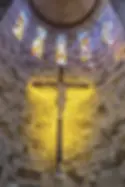
THE BURNING BUSH
In the Judeo-Christian Scriptures, the first time God reveals His Holy Name is when He speaks to Moses from a Burning Bush. What could be more appropriate in the Church of the Holy Name than a tabernacle depicting the Burning Bush? This bush with which Moses conversed was on fire and yet—mysteriously—it was not consumed (Exodus 3:2–15). And when Moses asked the voice to identify itself, the name which it revealed was equally mysterious, “I Am Who Am” (3:13-14). Judeo-Christian tradition has come to understand this mysterious name for God as meaning, “I am the One who always is, the Source of all existence; I always have been, I am, and always will be; and I am with you.”
An original bronze sculpture by Dale Montagne, the Tabernacle beneath the crucifix is meant to reflect God’s mysterious presence in the Burning Bush. The implication is obvious: The Eucharistic presence of Christ abiding in the tabernacle continues to say, “I Am with you.” The flames contain pieces of dichroic glass which is both see-through and reflective. It reflects different colors according to the angle of light and the position of the viewer, adding liveliness and mystery to its appearance. This Tabernacle connects through the wall to the altar in the Sacred Heart Chapel, so that the main church and the smaller chapel share the same symbol of God’s abiding presence. The windows on either side of the sanctuary contain small pieces of fire-colored glass to show their connection to the Burning Bush Tabernacle. The mysterious One present in the fire is revealing himself more clearly in the person of Jesus who claimed the title “I Am …”

THE CRUCIFIX
The crucifix appears to be suspended between earth and heaven where Jesus offers himself as a victim of love. He alone is worthy to wield the fiery sword of perfect love and with it melt the chains of sin and death.
The crucifix of Holy Name Church was donated by members of the Cullen, Squire and Hogue Families in 1964, in memory of Anne Cullen Squire who was killed in an auto accident. Ann was one of the founding members of Holy Name Parish along with Fr. John J. Meyers who was pastor from 1907–1938. So, not only has this crucifix graced the sanctuaries of the last two churches, but it also represents a connection to the first generation of our parish family. The century-old church of Routt County, along with the two millennia of Christian tradition, have been inspired by the cross—a revelation of divine providence that invites our contemplation.
We are redeemed from sin and death and restored to the tree of life (Revelation 22:14) in the Holy Name of Jesus Christ. Therefore, on either side of the crucifix there are square windows depicting the Holy Name and title of our Church.

























